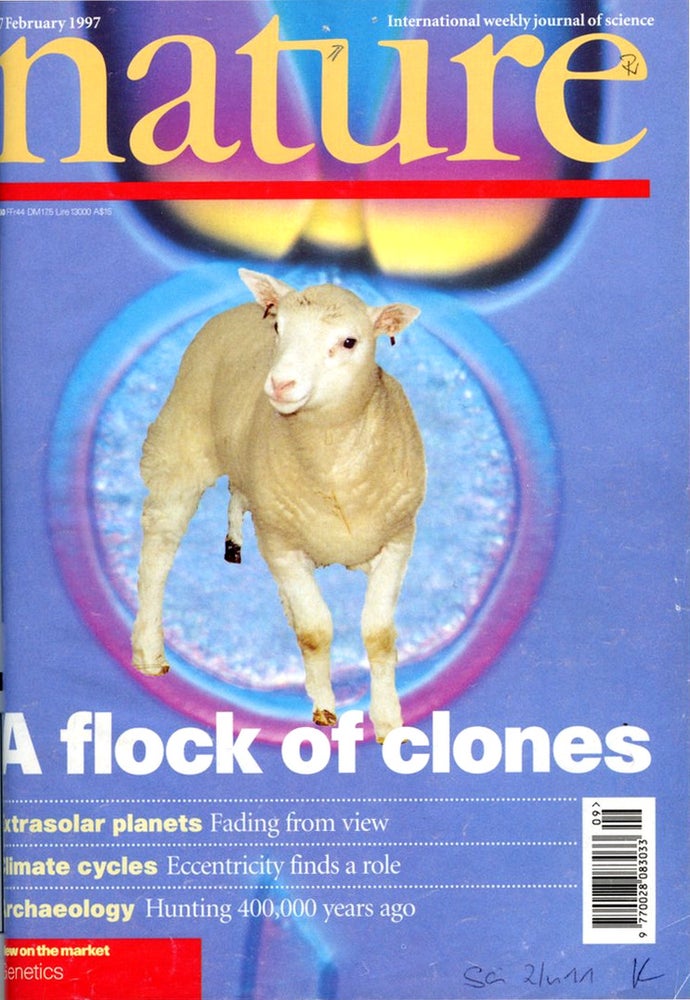Viable Offspring Derived From Fetal and Adult Mammalian Cells WITH An Udder Way of Making Lambs (Comment by Stewart) in Nature 385, no. 6619, February 27, 1997, pp. 810-813; (Wilmut & Campbell); 769-771 (Stewart)
London: Macmillan Co., 1997. 1st Edition. Full volume. 1st EDITION WITH ORIGINAL FRONT WRAP PRESENT OF THE LANDMARK CLONING OF THE FIRST MAMMAL, DOLLY. NO ADDRESS LABEL. British biologists Sir Ian Wilmut and Keith Campbell announced the cloning of Dolly in this paper, the first account of their efforts and research. Considered one of the most significant scientific breakthroughs in history, Dolly’s birth (and survival until 2003) proved that mammals could be cloned from adult somatic cells through the process of nuclear transfer – essentially, adult cells could reprogram themselves into a new being.
“Working at the Roslin Institute [part of the University of Edinburgh] in the mid-1990s, Keith Campbell, a coworker of Wilmut’s “found a way to turn back the clock of a mature, differentiated cell. He deprived cultured udder (mammary) cells from adult ewes of nutrients for five days, forcing the cells into a ‘sleeping’ state in which many of their genes shut down. Wilmut and Campbell fused each quiescent mammary cell with a normal sheep egg cell from which the nucleus had been removed, and the cytoplasm in the egg cell somehow reprogrammed the adult cell’s genes so that the combined cell could produce offspring cells able to differentiate into many different types. When the fused cell began to develop into an embryo, the scientists implanted it into the uterus of another ewe.
“A lamb produced by this method (one of 277 attempts) was born from the mammary cell of a six-year-old Finn-Dorset ewe on July 5, 1996. Wilmut’s group named her Dolly, after country-western singer Dolly Parton” (Yount, A to Z Biologists, 334). Transferring the cell nucleus from an adult into a developing egg cell that had had its cell nucleus removed – nuclear transfer -- meant that Dolly had, essentially, three mothers (one provided via the egg, another via DNA, and the third carried the cloned embryo to term.
Wilmut and Campbell’s work, cloning an entire mammal from a somatic cell, has since been replicated with other mammals. Scientifically and socially we are only beginning to investigate the full implications, biological, philosophical and ethical of their breakthrough.
ALSO INCLUDED: Also included in this issue is ‘An Udder Way of Making Lambs’ by Colin Stewart. Stewart was asked to write essentially an ‘editorial’ on Wilmut and Campbell’s work; in it Stewart both comments on the creation of Dolly and some of the questions raised by the science. Item #1577
CONDITION & DETAILS: Full volume. Ex-libris -- with the usual markings (though none to the Dolly issue). The front wrap features a photograph of Dolly on the cover, no rear cover; no address label. 4to. 11 x 8.5 inches (275 x 213mm). The Dolly issue has very slight scuffing at the edges and two ink marks on the front wrap (see picture). Both the volume and the issue bound and bright. Very good condition.
Price: $1,000.00

